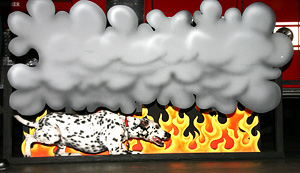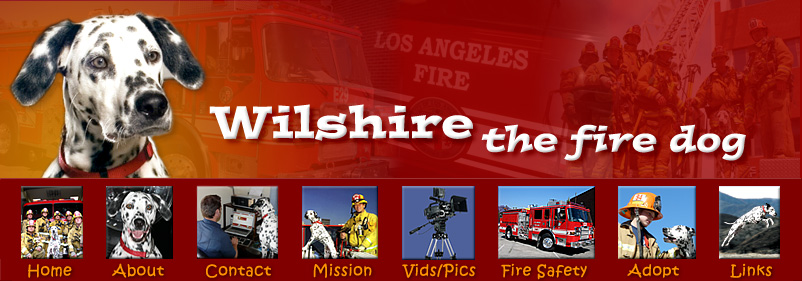|
911
In case of an
emergency, know how to dial 911 for help. If you donít know how, ask
your parents or older siblings to unplug a phone and show you how.
Just remember, dial 911 only in emergencies!
Make sure and post
emergency phone numbers by the telephone.
back
to top
FIRE ALARMS
Make sure you have
fire alarms in every level of your house and that they are tested
monthly. Batteries should be replaced every six months.
back
to top
HOUSE ESCAPE
Go over your house
plan and learn two ways out of each room in case of an emergency For
instance, one way out would be the door and a second way out could
be a window. Familiarize yourself with these two exits. Practice
with the whole family every six months.
Safety tip:
In case of fire,
you should first check around a closed door by holding the back of
your hand against the doorframe and the space between the door and
frame. If itís warm, thatís telling you there's a fire nearby. Use
your second exit.
back
to top
SAFE MEETING PLACE
Itís very
important is to have a safe place to meet up with the rest of your
family outside the house such as a neighborís house, a tree, etc.
This should be far enough away from the house and emergency
equipment for maximum safety.
Wait at your pre
planned safe meeting place. Ask a firefighter for assistance.
DONíT ever go back into a burning building!
back
to top
PASSIVE ESCAPE PLAN
If you are unable
to leave your home or building have what the firefighters call a
passive escape plan.
* Seal all doors
and vents with duct tape or towels to prevent smoke from entering
the room.
* Open a window
at the top and bottom so fresh air can enter. Be ready to close the
window immediately if it draws smoke into the room.
* Call the fire
department and let them know that you are still inside the building.
* Wave a
flashlight or light colored cloth at the window to let the fire
department know where you are located.
* Alert a
firefighter by making noise such as banging items together.
Whistling or calling out. Stay calm.
back
to top
EMERGENCY SUPPLIES
Assemble a family
disaster supplies kit (PDF,
257 KB) and keep a smaller one in the trunk of your vehicle.
back
to top
PETS
Have a plan for
your pets. Know where all the local shelters are and have their
phone numbers handy. Stock 3 days extra food and water for your pet
in case of emergency. (Go to the Adopt button for more
information.)
back
to top
STOP DROP AND ROLL!
 In case your
clothes were ever to catch fire, itís very important not to run.
Running causes the fire to grow. In case your
clothes were ever to catch fire, itís very important not to run.
Running causes the fire to grow.
STOP where you
are.
DROP to the
ground. Cover your eyes, nose, and mouth with your hands for
protection.
ROLL like a, well
roll like Wilshire! Roll over and over until the flames are out.
(View the Stop
Drop and Roll movie with Wilshire and firefighter Ryan on the Vids page)
back
to top
GET LOW AND GO!
 Smoke is very
dangerous! Smoke and heat rise, so during a fire there's cleaner,
cooler, and safer air near the floor. Smoke is very
dangerous! Smoke and heat rise, so during a fire there's cleaner,
cooler, and safer air near the floor.
So you want to get
down to the SAFE AREA. Get down as low as you can. Get on your belly
and crawl to your nearest escape exit. Remember get under the smoke
and GET LOW AND GO!
(View the Get Low
And Go movie with Wilshire and firefighter Ryan on the Vids page)
back
to top
FOR PARENTS
EMERGENCY PLANNING
Prepare an
emergency supplies kit
Disaster can occur
suddenly and without warning. They can be frightening for adults,
but they are traumatic for children if they don't know what to do
when these events occur. Children depend on daily routines. When an
emergency disturbs their routine, children can become nervous. In an
emergency, they'll look to parents or other adults to help.
How parents react
to an emergency gives children an indication on how to act. They see
their parents' fear as proof that the danger is real. A parent's
response during this time may have a long-term impact. Including
children in the family's recovery plans will help them feel that
their life will return to normal.
Families should
prepare an emergency
supplies kit (PDF,
257 KB) and develop a plan. Practice your plan so that everyone will
remember what to do in an emergency. Everyone in the home, including
children, should play a part in the family's response and recovery
efforts. Remember: make the plan simple so everyone can remember the
details.
Discuss what to do
in an evacuation. When told by officials, go immediately to a
shelter as instructed or to the home of a friend or relative who
lives out of the area. Find out about your local shelters
beforehand.
Know evacuation
routes. Pre-establish several different routes in case certain roads
are blocked or closed.
Family members can
become separated during an emergency. Be prepared by creating a plan
for how to reach one another. Establish an out-of-area contact (such
as a relative or friend) who can coordinate family members'
locations and information should you become separated. Make sure
children learn the phone numbers and addresses, and know the
emergency plans.
Quiz children
every six months so they remember what to do, where to go, and whom
to call in an emergency.
Decide how to take
care of pets. Pets are not allowed in places where food is served,
so you will need to have a place to take your pets if you have to go
to a shelter.
__________________________________________________________________
HOME FIRE ESCAPE
PLAN
Planning and
practicing a home fire escape plan is a smart thing to do. Get
together with your family to draw a plan of your home that includes
all windows and doors. Here are some important tips to help you make
your plan:
1. Two Ways Out:
Every room should have two ways out. One way out would be the
door and the second way out may be a window. If your
first way out is blocked by fire or smoke you should use your second
way out. Emergency escape from a second story window may involve
using a home fire safety ladder. If your escape plan includes an
escape ladder, practice using it from a first floor window with a
grown-up.
2. Working Smoke
Alarms:
Make sure your home has at least one smoke alarm on every level
and outside the sleeping areas. If you sleep with your bedroom door
closed, ask a grown-up to install a smoke alarm inside your bedroom.
Ask a grown-up to test your smoke alarms each month by pushing the
test button, and to replace the batteries once a year or when it
makes a chirping sound, which means the battery, is running low.
NOTE:
Newer smoke alarms have a universal signal repetition of 3 beeps,
followed by a 1 1/2 second pause.
3. Outside Meeting
Place:
Pick a family meeting place outside the home, where everyone will
meet once they have escaped. A good meeting place would be a tree, a
streetlight, a telephone pole, or a neighbor's home. Be sure to stay
a safe distance from emergency vehicles.
4. Lots of
Practice:
Practice your plan with your family at least twice a year. Get your
family together for tonight and practice your "great escape."
Remember: Never go back inside a burning building. Once out, stay
out!
If you live in an
apartment building, here is some special information for you.
In some cases,
the safest action when a fire alarm sounds may be to stay inside
your apartment and protect yourself from smoke until the fire
department arrives. This is called a "passive escape." If escaping
is your best course of action, follow your escape plan unless there
is immediate danger. Take your key with you in case you are forced
to return to your apartment. Always use the stairs - never the
elevator- in case of fire alarms. An elevator may stop at a floor
where the fire is burning or it may malfunction and trap you.
_________________________________________________________________
SLEEP OVER CHECK
LIST
A checklist to
help parents and caregivers consider hazards and make decisions
about slumber parties and sleep overs.
"Before you permit
your child to sleep over with a friend, talk to the child's
parents," says Judy Comoletti, NFPAīs Assistant Vice President for
Public Education. "Depending on what you learn, it can either
uncover serious fire dangers or give you peace of mind during your
child's sleep over."
Before you say
"yes"
How well do you
know the home?
Is the home
clean? Does it appear to be structurally sound?
Is the home in a
safe area?
If the home has
security
bars on doors and windows,
do you know for certain that the bars have quick release devices
inside, so your child could get out in an emergency?
Is your child
comfortable in the home and with all the occupants?
Are you
comfortable leaving your child in the home overnight?
How well do you
know the parent(s)?
Are they
mature, responsible and conscientious?
Will they
supervise the children throughout the stay?
Will they remain
sober and attentive?
Are they
cautious with
smoking materials,
matches and lighters, and candles?
back
to top
Ask the parents
Are there working smoke
alarms on
every level, throughout their home? Are the alarms interconnected?
Do they have a
well-rehearsed fire
escape plan that
includes two ways out and a meeting place outside?
Where will your
child be sleeping? Is there a smoke alarm in or near the room? Are
there two escape routes from the room?
Will the parents
walk through their escape plan with your child?
Do the parents
prohibit bedroom candle use
by children?
From nfpa.org
back to top
|

